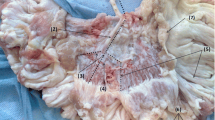Summary
This study was aimed at analysing the contractile response of the dog saphenous vein to chloroethylclonidine. At 37°C, chloroethylclonidine (0.1–100 μmol·1−1) caused along-lasting contraction in both proximal and distal segments of the dog saphenous vein, reaching 77.6 and 52.6% of the maximal response to phenylephrine, respectively. At 18°C, and in both segments, the maximal response to chloroethylclonidine was markedly reduced, whereas that to phenylephrine was not changed and that to UK-14,304 was enhanced. The response to chloroethylclonidine was unaffected by pretreatment with cocaine. Warming to 37°C caused contraction of strips which at 18°C had remained unresponsive to chloroethylclonidine, even if these strips were repeatedly washed before warming. At 18°C, chloroethylclonidine (100 μmol·1−1) did not alter the responses to UK-14,304 and phenylephrine.
At 37°C, the contractile response to chloroethylclonidine was antagonized by yohimbine, rauwolscine and prazosin, with the potency rank yohimbine = rauwolscine > prazosin. Phenoxybenzamine (30 nmol · 1−1) displaced the concentration-response curve to chloroethylclonidine to the right and depressed its maximum. After phenoxybenzamine, yohimbine continued to be more effective than prazosin, which remained very potent.
We concluded that: 1) the contractile response of the canine saphenous vein to chloroethylclonidine (both in the absence and in the presence of phenoxybenzamine) is predominantly alpha2-adrenoceptor-mediated since it is larger at the proximal than at the distal level of the vein and since it is more sensitive to yohimbine and rauwolscine than to prazosin; 2) the response to chloroethylclonidine and UK-14,304 are apparently due to activation of different alpha2-adrenoceptor subtypes, since prazosin was much more effective against chloroethylclonidine than against UK-14,304, and since at 18°C chloroethylclonidine “occupies” receptors without changing the response to UK-14,304; 3) there is a component of alphal-adrenoceptor stimulation in the response to chloroethylclonidine, since 30 nmol·1−1 phenoxybenzamine partly antagonized the effect of chloroethylclonidine; 4) since the responses to UK-14,304 and chloroethylclonidine are differently affected by cooling, there is some step (or steps) in the chain of events between the receptor and the final response, which is different in the two pathways.
Similar content being viewed by others
References
Black JW, Duncan WAM, Shanks RG (1965) Comparison of some properties of pronethalol and propranolol. Br J Pharmacol 25: 577–591
Bültmann R, Starke K (1993) Chloroethylclonidine: an irreversible agonist at prejunctional α2-adrenoceptors in rat vas deferens. Br J Pharmacol 108:336–341
De Mey J, Vanhoutte PM (1981) Uneven distribution of post-junctional alpha1- and alpha2-adrenoceptors in canine arterial and venous smooth muscle. Circ Res 48:875–884
Flavahan NA, Lindblad L-E, Verbeuren TJ, Shepherd JT, Vanhoutte PM (1985) Cooling and alpha,- and alpha2-adrenergic responses in cutaneous veins: role of receptor reserve. Am J Physiol 249:H950-H955
Giles RE, Miller JW (1967) Studies on the potentiation of the inotropic actions of certain catecholamines by U-0521 (3,4-dihydroxy-2-methylpropiophenone). J Pharmacol Exp Ther 157:55–61
Gonçalves J, Proença J, Albuquerque AA, Paiva MQ (1989) Hypothermia induces supersensitivity of mouse vas deferens to adrenergic agonists: evidence for postjunctional alpha2-adrenoceptors. J Pharm Pharmacol 41:52–54
Guimarães S, Nunes JP (1990) The effectiveness of alpha2-adrenoceptor activation increases from the distal to the proximal part of the veins of canine limbs. Br J Pharmacol 101:387–393
Guimarães S, Osswald W (1969) Adrenergic receptors in the veins of the dog. Eur J Pharmacol 5:133 -140
Guimarães S, Brandão F, Paiva MQ (1978) A study of the adrenoceptor-mediated feedback by using adrenaline as a false transmitter. Naunyn-Schmiedeberg's Arch Pharmacol 305:185–188
Guimarães S, Paiva MQ, Polónia JJ (1983) Alpha1- and alpha2-adrenoceptors of the dog saphenous vein and their relation to the sympathetic nerve terminals. Prog Neuropsychopharmacol [Suppl]:155 (abstr)
Guimarães S, Paiva MQ, Moura D (1987) Alpha2 adrenoceptor mediated responses to so-called alpha, adrenoceptor agonists after partial blockade of alpha1 adrenoceptors. Naunyn-Schmiedeberg's Arch Pharmacol 335:397–402
Han C, Li J, Minneman KP (1990) Subtypes of alpha1-adrenoceptors in rat blood vessels. Eur J Pharmacol 190:97–104
Harker CT, Ousley PJ, Bowman CJ, Porter JM (1991) Cooling augments alpha2-adrenoceptor-mediated contractions in rat tail artery. Am J Physiol 260:H1166-H1171
Hicks PE, Barras M, Herman G, Mauduit P, Armstrong J, Rossignol B (1991) Alpha-adrenoceptor subtypes in dog saphenous vein that mediate contraction and inositol phosphate production. Br J Pharmacol 102:151–161
Kerker J, Michel MC (1992) Affinity and alkylating effects of chloroethylclonidine at α1- and α2-adrenoceptor subtypes. NaunynSchmiedeberg's Arch Pharmacol 345 [Suppl 2]:R57
Leclerc G, Rouot B, Schwartz J, Velly J, Wermuth CG (1980) Studies on some para-substituted clonidine derivatives that exhibit an alpha-adrenoceptor stimulant activity. Br J Pharmacol 71:5–9
Minneman KP (1988) Alpha1-adrenergic receptor subtypes, inositol phosphates, and sources of cell Ca2+. Pharmacol Rev 40:87–119
Muramatsu I, Ohmura T, Kigoshi S, Hashimoto S, Oshita M (1990) Pharmacological subclassification of alpha1-adrenoceptors in vascular smooth muscle. Br J Pharmacol 99:197–201
Nunes JP, Guimaraes S (1992) Chloroethylclonidine is an agonist in the dog saphenous vein. In: Abstracts of the 7th International Catecholamine Symposium, Amsterdam 1992, p 237
Nunes JP, Moura D, Guimarães S, De la Lande IS (1991) Postsynaptic alpha-adrenoceptors in the perfused canine saphenous in vein in vitro. Pharmacol Res 23:409–414
Oriowo MA, Bevan JA (1990) Chloroethylclonidine unmasks a non-alpha-adrenoceptor noradrenaline binding site in the rat aorta. Eur J Pharmacol 178:243–246
Oriowo MA, Bevan RD, Bevan JA (1992) Vascular alpha-adrenoceptor affinity variation is not due to varying populations of subtypes distinguished by WB 4 101 and chlorethylclonidine. Eur J Pharmacol 216:415–420
Piascik MT, Sparks MS, Pruitt TA, Soltis EE (1991) Evidence for a complex interaction between the subtypes of the alpha1-adrenoceptor. Eur J Pharmacol 199:279–289
Ruffolo RR, Nichols AJ, Stadel JM, Hieble JP (1991) Structure and function of alpha-adrenoceptors. Pharmacol Rev 43:475–505
Sokal RR, Rohlf FJ (1981) Biometry. The principles and practice of statistics in biological research. Freeman, New York
Starke K (1981) α-Adrenoceptor subclassification. Rev Physiol Biochem Pharmacol 88:199–236
Trendelenburg U (1966) Mechanisms of supersensitivity and subsensitivity to sympathomimetic amines. Pharmacol Rev 18:629–640
Author information
Authors and Affiliations
Additional information
Correspondence to S. Guimarães at the above address
Rights and permissions
About this article
Cite this article
Nunes, J.P., Guimarães, S. Chloroethylclonidine irreversibly activates postjunctional alpha2-adrenoceptors in the dog saphenous vein. Naunyn-Schmiedeberg's Arch Pharmacol 348, 264–268 (1993). https://doi.org/10.1007/BF00169154
Received:
Accepted:
Issue Date:
DOI: https://doi.org/10.1007/BF00169154




